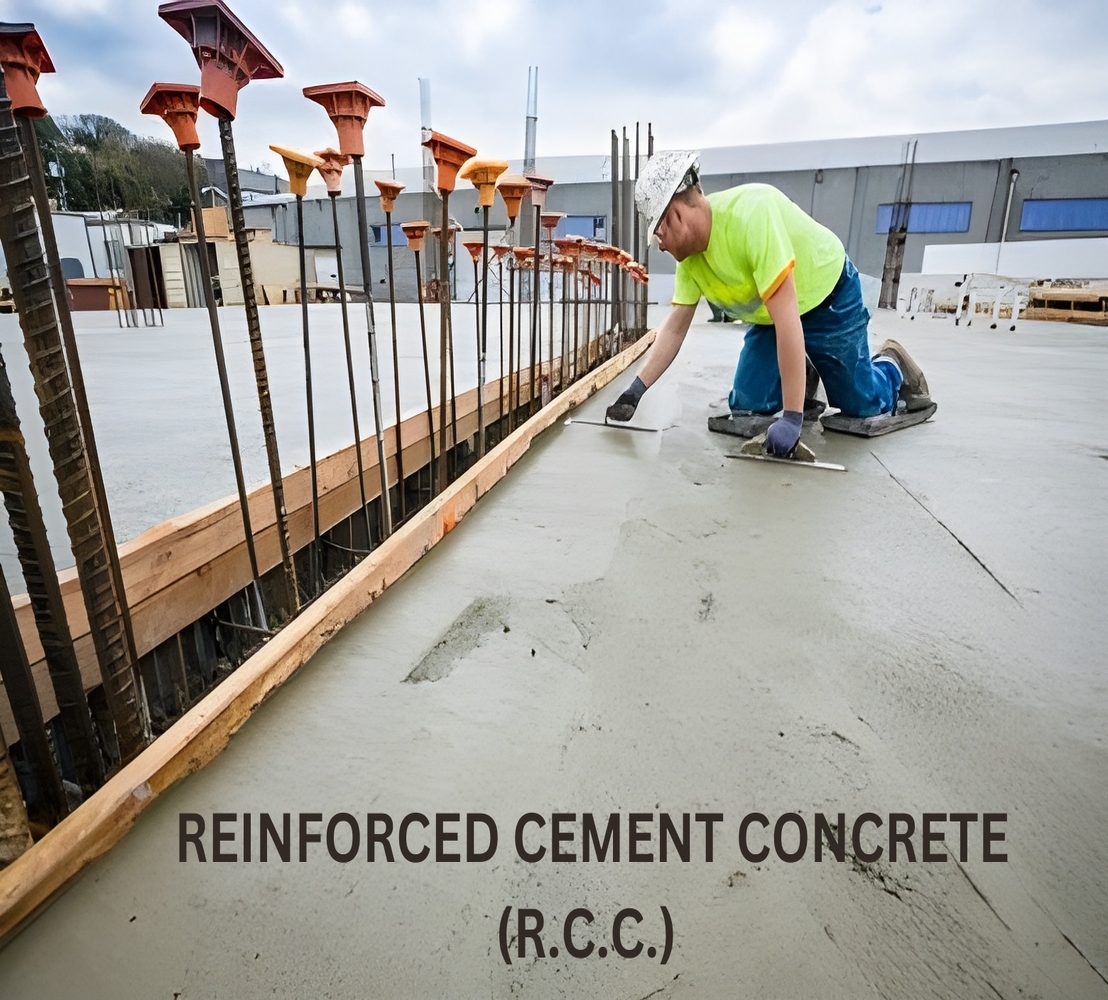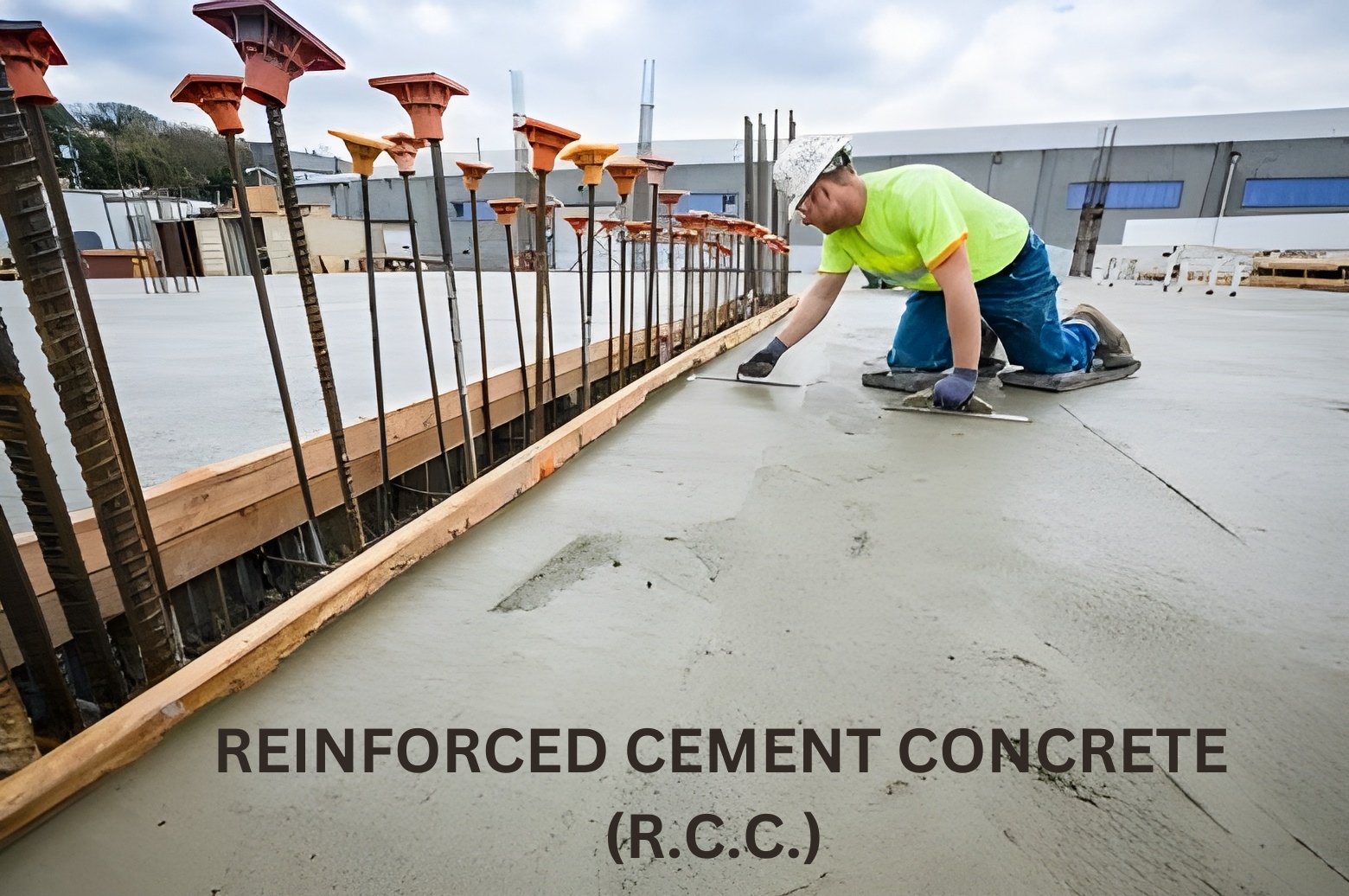Introduction
Reinforced cement concrete (RCC) is highly versatile and durable, making it a key material in construction projects such as skyscrapers and bridges.Here we will explores the composition, properties, applications, and impact of RCC in modern engineering.
Concrete resists compressive forces effectively but fails under tension. Engineers add reinforcement wherever they expect tensile stresses. They typically use steel because it offers high tensile strength and bonds well with concrete. Its high modulus of elasticity allows it to resist large tensile forces with minimal deformation, which makes it an ideal partner to concrete in structural applications.
Hairline cracks in concrete inevitably form in the tensile zone. Engineers typically use mild steel or ribbed steel bars ranging from 6 mm to 32 mm in diameter for reinforcement. They prepare a reinforcement cage based on the design specifications, place it inside the formwork, and then pour fresh (green) concrete. Once the concrete hardens, they remove the formwork. The resulting composite material, known as reinforced cement concrete (R.C.C.), functions as a structural member and effectively resists both tensile and compressive stresses.
Properties of R.C.C./Requirement of Good R.C.C.
Uses of R.C.C.
R.C.C. is used are:
- Footings
- Columns
- Beams and lintels
- Chejjas, roofs and slabs
- Stairs
2. R.C.C. is used for the construction of storage structures like
- Water tanks
- Dams
- Bins
- Silos and bunkers
3. It is used for the construction of big structures like
- Bridges
- Retaining walls
- Docks and harbours
- Under water structures
4. It is used for pre-casting
- Railway sleepers
- Electric poles
5. R.C.C. is used for constructing tall structures like
- Multistorey building
- Chimney
- Towers
6. It is used for paving
- Roads
- Airports
7. R.C.C. is used in building atomic plants to prevent danger of radiation. For this purpose
R.C.C. walls built are 1.5 m to 2.0 m thick.
REINFORCED BRICK CONCRETE (RBC)
PRESTRESSED CONCRETE (PSC)
Concrete exhibits very low tensile strength, so engineers exclude it from load-bearing calculations in reinforced concrete (R.C.C.) design. In R.C.C., the concrete in tension zones primarily provides cover and positioning for the steel reinforcement, without contributing much to structural strength. This leads to underutilization of a significant portion of the concrete. To solve this issue, engineers developed prestressing, a technique that allows full use of concrete. By introducing calculated compressive stresses into regions that will later face tension, prestressed concrete neutralizes these tensile forces and improves the structural element's performance.
In prestressed concrete (PSC) structures, engineers introduce compressive stresses in targeted areas before applying external loads. As a result, any external load must first counteract these pre-induced compressive stresses before it can create tensile stresses in the concrete. This approach ensures that the entire concrete cross-section contributes to resisting the load. By preventing the formation of hairline cracks, PSC greatly enhances structural durability. It also offers superior fatigue strength and experiences less deflection, making it ideal for long-span structures.
Engineers widely use prestressed concrete (PSC) to construct bridges, large column-free slabs, and roofs. Manufacturers also use PSC to produce railway sleepers and electric poles.
PSC uses high tensile steel and high-strength concrete. In pretensioning, engineers stretch the wires before placing the concrete, and then release the wires after the concrete sets. In post-tensioning, workers create ducts within the concrete elements. Once the concrete hardens, they insert prestressing wires through these ducts, stretch the wires, and anchor them directly to the concrete elements using special anchoring systems.
FIBRE-REINFORCED CONCRETE (FRC)
Plain concrete has limitations like low tensile strength, limited ductility, and poor crack resistance. Cracks can form even before loading and worsen under stress, exposing concrete to environmental damage. To counter this, engineers add uniformly dispersed fibres during mixing to stop crack growth and improve performance. Fibre-reinforced concrete combines concrete or mortar with fibres such as steel, nylon, coir, glass, carbon, and polypropylene, typically 0.25–0.75 mm in diameter with length-to-diameter ratios of 30–150.
Fibre reinforced concrete is having better tensile strength, ductility and resistance to cracking.
Uses of FRC
benches, bus shelters etc.
CELLULAR CONCRETE
Properties of cellular concrete
Uses of Cellular Concrete
FERRO-CEMENT
Ferrocement combines ferrous materials with cement, using steel wire meshes embedded in Portland cement mortar. Mesh wires range from 0.8–1.0 mm in diameter, spaced 5–50 mm apart. Mortar typically has a 1:2 or 1:3 cement-sand ratio. Engineers often add 6 mm steel bars at wider intervals, especially in corners. Sometimes, baby jelly replaces sand. The water-cement ratio is usually 0.4–0.45.
The method of ferrocement employs the direct shaping and plastering of the reinforcement, thereby negating the necessity for conventional formwork. Structural strength is provided by at least two overlapping layers of steel mesh. As defined by the American Concrete Institute, ferrocement is a thin-walled reinforced concrete structure. Its makeup involves hydraulic cement alongside mesh of continuous, small diameter, which can be either metallic or comprised of any other material fit for reinforcing the concrete.
Ferro-cement is fast emerging as an alternate material for timber. The history of ferro-cement goes back to 1843 (even before RCC). Joseph Louis Lambet constructed several rowing boats, plant plots and garden seats using ferro-cement. In early 1940’s noted Italian engineer and architect Pier Luigi Nervi carried out scientific tests on ferro-cement and used it to replace wood wherever possible.He built small tonnage vessels, the largest being 165 tons motor sailor. Nervi also pioneered the architectural use of ferro-cement in buildings. Ferro-cement can be given the finish of teak wood, rose wood etc. and even for making tables, chairs and benches it can be used.
Properties of Ferro-cement
Uses of Ferro-cement
Conclusion
In short Reinforced Cement Concrete, composed of cement, aggregates, water, and reinforcements, showcases advancements in construction technology. The combination of these elements creates a versatile material that offers structural stability and flexibility for various architectural designs and engineering tasks. RCC's lasting impact in the construction industry symbolizes strength and innovation.

